Stories from the Shack
I've had some truly great moments in this hobby, both while operating and while troubleshooting a technical problem, and I thought it would be fun to write down some of those experiences. Maybe they'll inspire you to try a different facet of our hobby, or help you solve a problem that is similar to one I experienced. (There is a special page of stories about 10 meters (my favorite band) here: http://www.bambinomusical.com/WB2HTO/10meters.html.)OSCAR
Hams have always been at the forefront of communication technology, starting with the first wireless stations which sent and received Morse code. Hams would later experiment with some of the first AM, FM, and even television stations, so it’s no surprise that they were early adopters of communication utilizing space. In fact, the Space Race was only four years old when OSCAR 1 was launched on December 12, 1961. OSCAR 1 was a very humble beginning to ham radio in space, as it was literally used as ballast to balance the payload of the Discover 36 mission, although it holds the distinction of being the first satellite to be ejected as a secondary payload and enter a separate orbit. According to the OSCAR Wikipedia page, “…the satellite carried no on-board propulsion and the orbit decayed quickly. Despite being in orbit for only 22 days, OSCAR 1 was an immediate success with over 570 amateur radio operators in 28 countries forwarding observations to Project OSCAR.”In 1974 after a series of successful launches of increasingly sophisticated satellites, Oscar 7 was launched, and that was followed fours later by the launch of Oscar 8. Both satellites were in low earth orbit (about 115 – 120 miles up) which meant they would only be in range at certain times and for a short period of time, but could both send and receive Morse code signals, permitting actual conversations. Both satellites acted as “repeaters,” receiving signals (the uplink) on the 2-meter band (144 – 148 MHz) and transmitting on the ten-meter band (28.000 – 29.000.) As a youngster who grew up thrilled by the exploits of Shepard, Grissom, and Glenn it was exciting to think that in some small way I could experience the Space Program first-hand and, using an azimuthal projection and a plastic overlay of Oscar 7 orbits (which had been included in an issue of QST, a ham radio magazine) it was easy to determine when the satellite would pass within range. I set my transceiver (the rig was a Tempo One) to the downlink frequency on 10 meters and, when the timing was right, I could actually hear a number of CQs and QSOs coming from space. That was pretty cool.
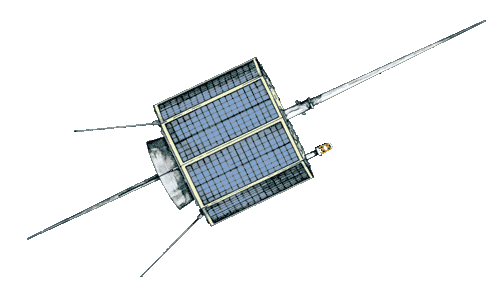
But I knew that the real fun would begin when I transmitted through the satellite, and so in the spring of 1977 I bought a used Hallicrafters VHF1 “Seneca” 2 meter transmitter, then constructed a 2-meter ground plane out of coat hangers, which I hung outside the shack window. Nothing fancy, as I had recently purchased a used TH3 beam for mounting on my parent's roof (these were GREAT parents) and knew eventually I would stack some sort of antenna for 144 - 148 MHz up there. Once I had the 2-meter transmitter working, I checked my QST Magazine for the satellite's latest schedule and, with my high-tech plastic overlay, saw that Oscar 7 would pass right over New York on the afternoon of June 6th, 1977.
I started hearing CW signals from other stations a few minutes after 1:00 pm (EDT) on 10 meters and began sending CQ (the internationally recognized abbreviation for “calling any station”) on 2 meters (remember that OSCAR was a 2 meter receive/10 meter transmit repeater). That’s when I heard… nothing. Huh. Well, since I didn't have a directional antenna I kind of figured the satellite, which was orbiting about 115 miles above, would have to be a lot closer to pick me up. So I tried again and - BINGO! - there it was, coming back to me on 10, my own signal! Now here's the really cool part: as I'm transmitting and the satellite is racing towards me at 17,000 miles an hour, I could hear the tone of the signal getting higher in pitch - the Doppler shift of my signal coming back from space. It got stronger too, as Oscar 7 passed almost directly overhead when, almost immediately the tones began to shift lower as the bird raced away and the opposite Doppler shift took effect. Well, I just thought that was the coolest thing to be able to actually hear that happening. As of this writing the experience is as vivid as any ham radio memory I have.
Repeated attempts at connecting with another station were unsuccessful, not surprising given the transmit antenna was non-directional and, geez, made of coat hangers. Two weeks later I bought and installed both a low-band HF beam and a Cushcraft circularly polarized 2-meter antenna stacked on top. Here’s how it looked shortly after installation. (My mom says she still gets heart palpitations thinking about me climbing on the roof.)
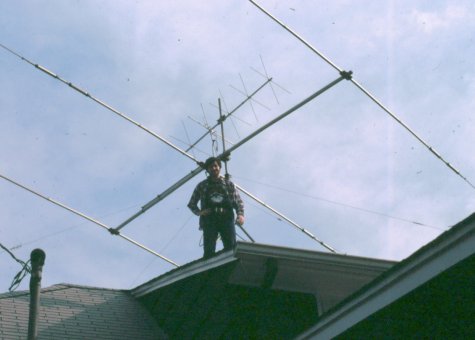
The roof of my parent's home in Merrick. That's me,
my TH3 beam and Cushcraft c/p 2 meter antenna.
With both transmit and receive directional antennas in
place, I was ready to go for a contact during OSCAR’s next
pass. On July 24, 1977 (Oscar 7's 12,294th orbit) I
made my first space-based QSO, with a ham in Florida
(WA4JID.) I subsequently would connect with dozens of
hams up and down the Eastern Seaboard and western Europe
through Oscar 7 and then, in the summer of 1978, dozens more
through Oscar 8. Yet I don't recall any of those QSOs
as vividly as I do when I first heard the dits and dahs of
my Doppler-shifted CW signal coming back at me from space.
SWR Problem
It was 2009 and with band conditions the way they were there hadn't been much reason to get on 10, 12, 15, or 17 meters for a while. One day, however, I was asked to help someone out with WAS for which they needed MA on 15. No problem. I went to tune up one of dipoles on 15, using the settings on the MFJ-941E tuner I had determined after first putting up each antenna. That's when I first noticed the problem: using the IC-718's TUNER fuction (which generates a watt or so of power, just enough to tune up on the actual antanna without causing any QRM) I would adjust for a nice low SWR. Then I would start to broadcast and the SWR meter would swing to infinity, and the rig, sensing the severe mismatch, would stop transmitting. I went back to 20 meters and was able to tune up, no problem. Back to 15 and the infinite SWR problem came back. Down to 30, 40, and 80 - no problems. Tried 17, and got the same pinning of the SWR meter. Same on 12 and - gulp - 10 meters! Was it the antenna?. Nope. Didn't matter which antenna I used (they were all dipoles of different lengths and fed with either twin-lead or coax.) Was it the the jumper cable between the rig and the tuner? Nope, I swapped it out and the problem was still there. Could it be the tuner? Easy to check with another rig, and I happen to have an HTX-10 (a portable 10-meter rig) which, when hooked up through the tuner into one of the dipoles worked fine. Damn. All signs were pointing to the rig as the source of the problem.
I signed onto forums on eham.net and qrz.com, as well as the ICOM 718 Yahoo Group and posted my problem. I'd like to say it was conforting to know that others were experiencing the EXACT same problem, but it was not, since none of the threads I found contained any answers (one thread actually stretched on for over a year without resolution) and it looked as if I would have to ship my rig to a service center. Before I did that, I decided to call one of the ICOM Service centers to see if maybe one of the techs had even ever heard or seen this problem, and maybe even offer a solution over the phone.
The Surprising Answer, and Fix
Here is what my new best friend - the technician at ICOM Service in Michigan - told me, and it's going to surprise you - the cover of tuning section of the IC-718 (crammed with torroids, caps, and switches) is a plate connected with about 10 small screws. The tech told me that over time moisture can cause a build-up, a contamination on the screws that prevent a tight electrical connection between the plate and the body of the tuning section - and that seal is critical in the IC-718 (as it would be for any rig,) especially on the higher bands.
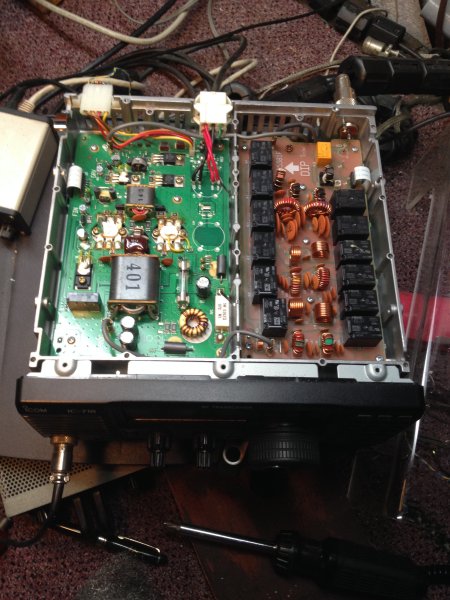
An IC-718 with the cover off, note the toroids on the right side (the plate has been removed)
* Remove the cover of the rig
* Take out the screws that hold down the plate on the right side of the rig (looking from the front)
* Clean the screws with steel wool
* Replace the plate with the now-clean screws
* Put back the cover of the rig
And that was it. The rig worked fine on 17, 15, 12, and 10 meters on all antennas and continues to work today - in part because once a year I clean those screws. At first it sounds crazy, that a few screws could cause an SWR problem, but if you think about it, not really. As one design engineer at my company (Analog Devices) once said to me "RF is funny."
It sure is, especially since I found the answer to my problem... (To bad that the QRZ.com thread was closed, I would have liked to have presented this solution.)
Noise

There is NOTHING more frustrating than a noise problem because the source of the noise could be anywhere. It may not be in your shack, your home, or even on your property.
I recently went through an exercise trying to find the source of S7 - S9 noise on all the HF bands. I have seen enough posts on various forums (like the ones I have used many times on eham.net) that I know it's something many other hams experience, and I thought by sharing my experience I could help others having similar problems. Right up front let me say that this is by no means a complete discussion on the subject of grounding, baluns, or noise. I encourage you to read the info posted at these links here do your own web search for more information, or the aforementioned eham.net forums. I welcome all link suggestions, edits, and corrections via email here.
Clues
So let's start off, as I did, with with a few easy things to check and fix.
* Check your rig's squelch setting (don't say "duh" - your hand could have slipped and accidentally moved the knob.)
* Turn off the PREAMP. You don't need it all the time - only for very low signals - and all it does is raise the noise floor most of the time.
* Is the noise time-dependant? Several summers ago I started experiencing a loud buzzing noise on every band that looked something like this on a digital waterfall. The clue was time. The noise appeared only as evening approached and at night. Soon after dawn the sound went away.
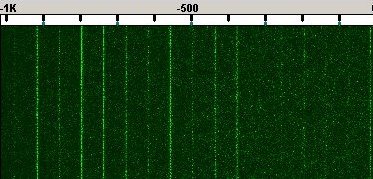
Waterfall of street lamp noise
That led several hams to suggest I contact the town's light department about a broken street lamp, which turned out to be the problem. (Reading has sodium lights and when the starters break they create wideband noise that can be heard on HF all over town.)
* Has anything changed at your QTH (is there a new piece
of equipment or appliance?)
* Check for ground loops. That means the path of the ground
cannot return to any previous point, it has to be a line of
devices, not looped back anywhere. Read this article
on removing
Ground
Loops.
* Speaking of ground, how is YOUR ground system? I'm gonna say what thousands have said before: You cannot understate the importance of a good ground system. "An improper ground wire can become an antenna" is how Ray, NR1R explained it to me. At the suggestion of Woody, WW1WW I pounded a ground rod (galvanzied copper) in the same hole as my sump pump.
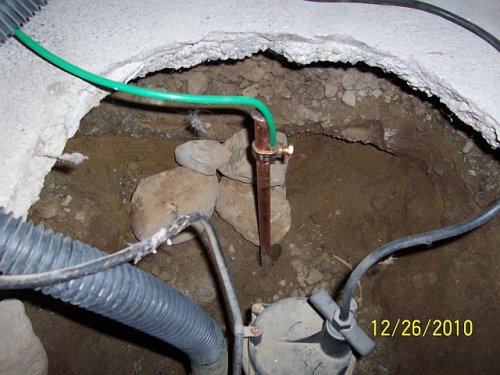
On the other side of the ground cable (braided #6) I installed these two ground bars. Each piece of equipment in the shack (the rig, the tuner, even the PC) gets its own braided wire ground connection. Looks neat and provides a great ground.
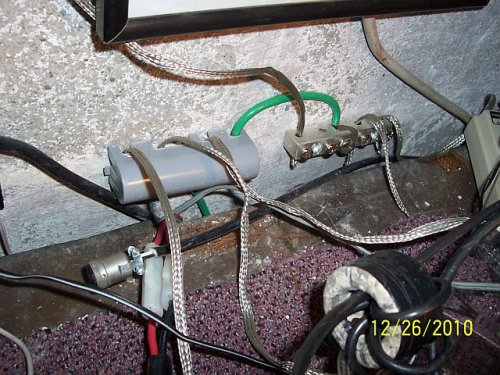 The next questions I got when
I was looking for the source of my 40 and 80 meter noise
problem had to do with the sound of the noise. Yes, noise
has different sounds.
The next questions I got when
I was looking for the source of my 40 and 80 meter noise
problem had to do with the sound of the noise. Yes, noise
has different sounds.
* There's the AC hum like that of an old tube radio, which could mean a bad power supply to the rig, or a problem with some other device in your shack or home (we'll get to the home question shortly)
* Do you hear the whine of a car engine (those of us who live near busy streets will tell you there are a lot of people who need to get their cars tuned!) Try using your rig's NOISE BLANK or other filters to reduces the issue.
* Is it more like "white noise," which is evenly distributed across the audio spectrum? Ugh. That's the tough one, because there are many possible sources. The good news is that if it's not something easily found (like a street lamp) there is a simple test for determining if it is coming from your home's electrical system: Hook your rig up to a battery and tune to a spot on the dial without any signals, where you are getting just the noise. (By the way, if you hooked up to the battery and the noise goes away I think you've found your problem - probably it's the rig's power supply.) Once running off the battery start to shut off breakers in your home one by one (here's another recoomendation from a married man - tell your wife and kids BEFORE you start doing this) and wait for the noise to go away.
Now you've located the specific breaker and can trace each device on that circuit by unplugging them one by one. If you find the guilty device then perhaps the power supply of that device is malfunctioning. Or, as Jim Brown (K9YC) explains in his terrific article A Ham's Guide to RFI, Ferrites, Baluns, and Audio Interfacing perhaps it is behaving exactly as designed - badly. Joe calls it the "pin 1 problem," an issue with many devices in the home today. Read the article - Jim explains it very well. Jim's recommendation is the same as Chuck Counselman (W1HIS) wrote a terrific article on Common Mode Chokes which also advocates the use of chokes to reduce or remove noise. Courtesy of Ray, NR1R, here's the jumper between the IC-718 and MFJ Tuner: a large toroid through which the coax has been wound four times.
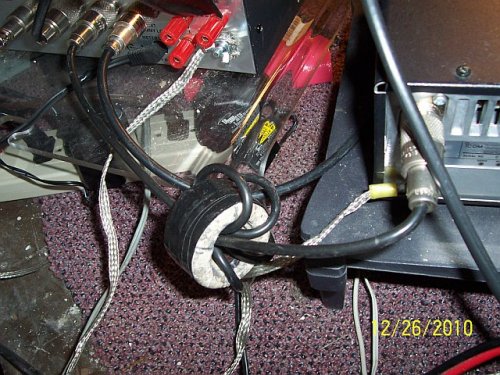
In my case (December, 2010) all the breakers (including the main breaker into the house) were turned off but the noise didn't go away, strongly suggesting that the source of the noise was external to the house. Now I understand why the Grinch was so grumpy - finding the source of the noise is proving to be elusive. But the large toroid choke, along with the improved ground system (along with judicious use of the PreAmp and Attenuator functions) has solved the problem. 40 and 80 will never be quiet bands, but they, along with all the other bands are in good enough shape to work and have fun.
Here are those links on Noise abatement I promised you:
W1HIS
article
on Common Mode Chokes (PDF)
A
Ham's Guide to RFI, Ferrites, Baluns, and Audio
Interfacing (PDF)
Article on removing Ground Loops
Blue... Hawaii
It's long been a goal of mine to complete 5BWAS. Back in the early 1970s, when I first got my ticket, and there was no Internet with all those chat rooms and spotters it was a lot more difficult to find the states you needed and to set up skeds, so 5BWAS was a real crap shoot. But even with all the help we have today, you still gotta make the contact which, in this terribly long sunspot dip, isn't easy, especially if you're working with humble dipoles. But it pays to be stubborn and by late 2010 I was down to two states on 80 meters. I am in MA so guess which two - yep, HI and AK - and had been chasing both in earnest since the Winter of 2008-09, using mostly JT65 to take advantage of its low signal detection capability. It was ironic that when I finally got Alaska (Les, KL7J) it was on good old sideband, (courtesy of the Geratol net) on 3.668 MHz. Just like with the South Pacific and Australian contacts on 10, it took a literal twist of the ionosphere to make AK happen on 80.
But I still was left needing Hawaii, almost twice as far from my humble dipoles as Alaska, and numerous attempts with several really patient Hawaii hams had been proving fruitless. By December 2010 I had developed a friendship with Rick, KH6SAT, who was also helping out a number of other mainlanders who needed HI on various bands and modes. Together we attempted to play the atmospheric angles - I would stay up late (0400 to 0600Z, around midnight here) or get up early (0800 to 1000z, just before sunrise here) to work grayline with Rick, but at neither time did we ever see even a wisp of signal from each other.
Since my company shuts down for the week after Christmas, I was able to get up every morning around 2 or 3 a.m. (0700 - 0800), and Rick and I would get on the WSJT Spotter and coordinate for a contact. For six mornings we tried, and for six mornings neither of us saw or heard any sign of each other's signal. What made this especially frustrating was that I could QSO easily with west coast stations and - get this - a VK2 station ---> on 80 meters. I could decode other VK stations, as well, and Rick had no problem reaching middle America - meaning that Rick and I were literally skipping right over each other!
Log 'em, Dano!
The last night of my vacation I got up around 2 or 3 a.m. - as I had been for the week - and went down to the shack (in the basement, nice and chilly this time of year) and went hunting for Rick. Once again, we coordinated via the WSJT Spotter on RF frequency and offset, but for the first hour things were not looking very good. Then, on what must have been my 20th attempt, Rick reported (via the WJST spotter) that he could hear tones. Before long he was decoding my signal, at a respectable -19 (at my strongest) and I could decode him at -24. I had Hawaii on 80 meters in my log!
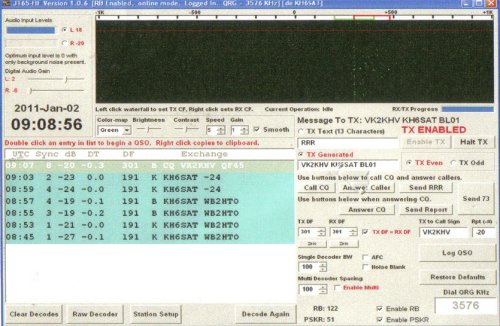 Screen
shot from Rick, KH6SAT, of my JT65 signal decoded in
Hawaii
Screen
shot from Rick, KH6SAT, of my JT65 signal decoded in
Hawaii